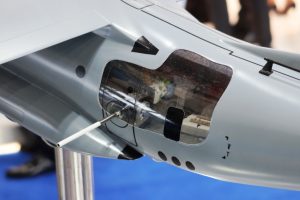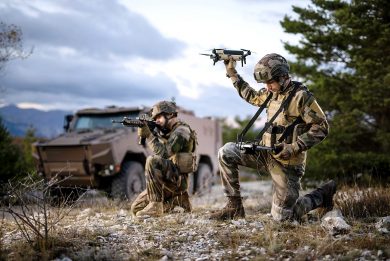
WDS 2024 – Leonardo showcases its C27J MPA configuration and details its gunship solution
At the World Defense Show Leonardo showcased the maritime patrol aircraft (MPA) version of its C27J Spartan, and detailed the gunship solution of that same aircraft
Leonardo is continuing improving and diversifying its offer based on the C27J twin turboprop tactical transport aircraft, the latest iteration of that platform being displayed at WDS. Developed looking at evolving capability requirements assessed across geographies, particularly in Europe and the Middle East, the scale model of the MPA was visible on the company booth alongside that of the gunship version, which for example has been in development for the Italian Air Force for some years.
The requirements for the MPA might differ in many aspects, EDR On-Line understood, Leonardo being ready to take in count specific needs of each customer. Such a platform should be capable to conduct antisubmarine (ASW) and anti-surface (ASuW) missions as well as full ISAR (intelligence, surveillance, and reconnaissance) missions, with also COMINT (communications intelligence) capabilities, and meet needs for endurance that exceeds that of the aircraft with standard fuel tanks. The configuration on show was initially conceived with a significant amount of Italian industrial content.

The most visible features of the C27J MPA are the three hardpoints present under each outer wing, the total underwing payload being 6,000 kg. For ASuW missions the company offers the Marte ER developed by MBDA Italy, while for ASW operations the weapon of choice is the MU90 lightweight torpedo developed and produced by EuroTorp, the French-Italian consortium established between Leonardo, Naval Group, and Thales.
One of the possible market solutions, to cope with long range requirements, is the adoption of a “wet” inner pylon, which allows installing an external fuel tank under each wing, considerably increasing the endurance, EDR On-Line understanding this should be around 12 hours.
The addition of a 3,000 kg load per wing was allowed by the design of the new wing, which winglet provides considerable lift at the extremity. A typical configuration would see the 1,000 kg fuel load on the inner pylon, the two other carrying 700 kg each, however a solution with three identical “dry” pylons might be adopted should the customer requirement not include extra-range capability.
Leonardo proposes the full self-protection suite based on that being developed as part of the Mid-Life Update (MLU) of the Italian Air Force C27J fleet. This includes the ELT radar warning receiver, Leonardo missile warning system providing 360° coverage and interfaced with the cockpit, one DIRCM (Directional Infrared Counter Measures) per side at the rear, Leonardo laser warning receiver, and MESS chaff and flare launchers, also capable to launch decoys. The communications suite will include line of sight radios as well as SATCOM Ku/Ka systems.

Coming to sensors, at the rear the C27J MPA is fitted with the magnetic anomaly detector (MAD) sensor. Two configurations are available, one with the MAD directly fitted to the rear of the aircraft, and one with a rear flat sponson containing VHF/UHF antennas for the COMINT role (HF antennas being installed along the fuselage). A chin mounted 15-inch gimbal is fitted (a bigger one being considered for the ISAR role) under the fuselage, followed by a search radar selected among Leonardo products. Rear doors are taken from the US Coast Guard configuration and are all transparent allowing an optimal view downwards. For ASW missions a sonobuoy launcher is available, the customer being free to select a pressurised or non pressurised solution.
As for the inside layout, starting from the front, a first pallet will host the rest area, while the second and third pallets will host five consoles on the right side of the aircraft, while on the left we find the galley and a storage area, the latter hosting sonobuoys or other equipment. Moving to the back we find the two observers’ stations, the ramp hosting the launchers for small markers and sonobuoys. Depending on customers’ requirements the Search And Rescue kit can be launched either from the ramp or from a hatch.
The C27J MPA is heavily based on the US Coast Guard configuration, Leonardo being able to deliver the aircraft in 36 months from the order, the same time needed to deliver the ATR platform in the maritime version.

Coming to the MC27J gunship, its’ development started some years ago under an Italian requirement aimed at providing Special Forces with adequate aerial fire support. Known as Praetorian, the aircraft was tested with different gun solutions, the one retained being the GAU-23 30mm automatic cannon, the aviation variant of Northrop Grumman’s Mk44 Bushmaster II. EDR On-Line understood that a precision guided munition solution might be retained as an alternative instead of the gun, should the customer focus on collateral damage considerations. The model seen at WDS was fitted with the palletised gun on the left side, however right and left, at the back of the aircraft three PGM launchers were visible.
As said, a debate is ongoing regarding hard kill effectors; the PGM solution would provide a major benefit, that of blending the aircraft into the general Spartan fleet, not making it a high value target for the enemy, as visually it will be very much the same, which would not be the case in the gun-fitted version.

The internal layout sees a first pallet dedicated to command and control systems, with Ku/Ka SATCOMs, and a full suite of radios for line-of-sight link with troops on the ground. It is followed by two pallets hosting seats for the Special Forces detachment, fitted with oxygen capability, then comes a pallet with SIGINT and jamming systems, followed eventually by the gun pallet. A chin-mounted 15- or 20-inch gimbal is installed providing ISAR and targeting capabilities.
Leonardo is currently carrying on trials with the Italian Air Force in order to freeze the configuration. This should happen soon, first aircraft availability being forecasted within three years. The aircraft will obviously benefit from all improvements recently introduced, among which the already mentioned winglets.
Photos by P. Valpolini



